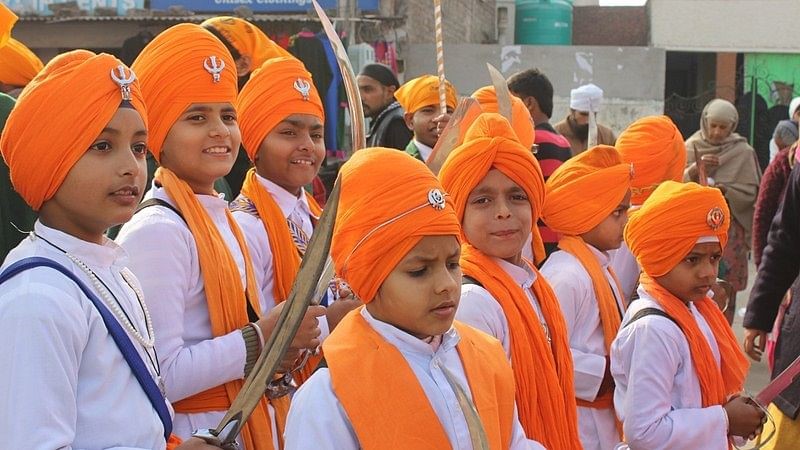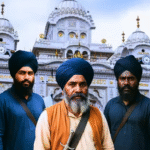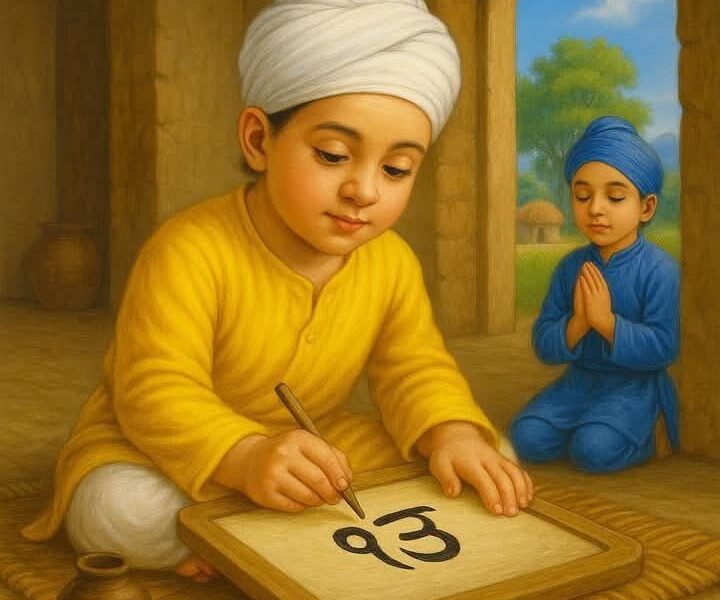Sikhism is a monotheistic faith that promotes equality and devotion to others. It is the world’s fifth most dominant religion. Sikh (pronounced “sickh”) is a word that signifies “disciple” or “learner.” Guru Nanak developed Sikhism in the Punjab region of India over 500 years ago. Sikhs believe in a single God who shelters and leads them. They believe that everyone is equal in the eyes of God. Sikhs believe that what you do matters and that you should live a good life.
 Turbans are worn to respect God and to hide our long hair. Sikhs wear their hair, beards, and moustaches uncut. The humanitarian concepts of freedom, equality, and fairness are taught in the Sikh faith, and they are the same ideas upon which this great democracy is built. The universality of the Sikh way of life appeals to people of all religions and cultures, inspiring us to see past our differences and work together for world peace and harmony.
The Khalsa, or ‘Community of the Pure,’ is the name given to the Sikh community of men and women. The Five Ks must be followed to become a Sikh and join the Khalsa
Kesh (uncut hair)
Sikhs regard the Kesh, also known as Kesa, or uncut, long hair, as an essential element of the human body.
Kangha (a wooden comb)
The Kanga is a wooden comb that is one of Sikhism’s five K’s, or articles of faith, known as kakar. It is available in a range of sizes, forms, colours, and wood types. Short fine teeth are seen in some kangas, while long wide teeth are found in others. Sikhs don’t shave their heads.
Kara (an iron bracelet)
A kara, or obligatory articles of faith in Sikhism, is an all-iron bangle or pure steel ring worn on the right arm’s wrist. The kara is not regarded as a valuable piece of jewellery. While only one kara is necessary to be worn and is often worn on the right wrist by both genders, additional karas may be worn on both wrists if desired.
Kachera (cotton underpants)
Kachhera is a loose undergarment worn by Sikhs, and it is one of the five Ks, or essential articles of faith, known as kakar in Sikhism. It’s made to move freely while remaining modest, whether you’re sitting cross-legged for worship, doing seva, or practising martial arts.
Kirpan (an iron dagger)
A kirpan is a ceremonial short sword worn by an initiated Sikh and is one of Sikhism’s five kakar, or articles of faith. The kirpan symbolises the Sikh warrior’s concept of defending the weak against tyranny, injustice, and forced conversion. In the past, the kirpan would have been a war weapon. Before degh and langar are eaten, the kirpan is used to bless them.
Sikh’s Holy Scripture
The Guru Granth Sahib is the Sikh sacred book. Guru Gobind Singh, the tenth Guru, predicted that there would be no more living gurus after him. Sikhs could instead consult their sacred book for instruction. Sikhs refer to their holy book as a Guru for this reason.
The Guru Granth Sahib is a compendium of teachings from the 10 gurus, and also saints from the Sikh, Hindu, and Muslim faiths. It is written in Punjabi and is regarded as the living word of God by all Sikhs. In the Sikh house of worship, it is kept on a raised platform under a canopy. When they are near it, all Sikhs remove their shoes.
History of Sikhs
Guru Nanak, the creator and spiritual leader of Sikhism, created the religion in the early 15th century. He was a staunch believer that everyone is born equal and should be given equal opportunity.
Guru, which means “spiritual leader,” led his people in the direction of God’s will, or Hukam, thinking that there’s only 1 eternal God to whom we were all accountable. Sikhs number in the millions around the world, and religion is open to everybody.
The Sikh religion is entirely monotheistic, believing in a single, all-powerful, all-knowing, all-powerful, all-knowing, all-knowing, all-knowing, all-knowing, all-knowing, all-know Life, according to Sikhism, is a once-in-a-lifetime opportunity to find and develop the divinity within each of us. Sikh belief is based on human rights and fairness, and Sikh history is littered with stories of Sikh Gurus and their followers making enormous sacrifices for the sake of religious freedom and justice. Sikhs have recently been recognised as some of the most distinguished warriors in the British armed forces during both World Wars. They played a key role in some of the most notable conflicts. Over two-thirds of those Indians convicted to life in prison during India’s battle for independence from the British were Sikhs.
Turbans are worn to respect God and to hide our long hair. Sikhs wear their hair, beards, and moustaches uncut. The humanitarian concepts of freedom, equality, and fairness are taught in the Sikh faith, and they are the same ideas upon which this great democracy is built. The universality of the Sikh way of life appeals to people of all religions and cultures, inspiring us to see past our differences and work together for world peace and harmony.
The Khalsa, or ‘Community of the Pure,’ is the name given to the Sikh community of men and women. The Five Ks must be followed to become a Sikh and join the Khalsa
Kesh (uncut hair)
Sikhs regard the Kesh, also known as Kesa, or uncut, long hair, as an essential element of the human body.
Kangha (a wooden comb)
The Kanga is a wooden comb that is one of Sikhism’s five K’s, or articles of faith, known as kakar. It is available in a range of sizes, forms, colours, and wood types. Short fine teeth are seen in some kangas, while long wide teeth are found in others. Sikhs don’t shave their heads.
Kara (an iron bracelet)
A kara, or obligatory articles of faith in Sikhism, is an all-iron bangle or pure steel ring worn on the right arm’s wrist. The kara is not regarded as a valuable piece of jewellery. While only one kara is necessary to be worn and is often worn on the right wrist by both genders, additional karas may be worn on both wrists if desired.
Kachera (cotton underpants)
Kachhera is a loose undergarment worn by Sikhs, and it is one of the five Ks, or essential articles of faith, known as kakar in Sikhism. It’s made to move freely while remaining modest, whether you’re sitting cross-legged for worship, doing seva, or practising martial arts.
Kirpan (an iron dagger)
A kirpan is a ceremonial short sword worn by an initiated Sikh and is one of Sikhism’s five kakar, or articles of faith. The kirpan symbolises the Sikh warrior’s concept of defending the weak against tyranny, injustice, and forced conversion. In the past, the kirpan would have been a war weapon. Before degh and langar are eaten, the kirpan is used to bless them.
Sikh’s Holy Scripture
The Guru Granth Sahib is the Sikh sacred book. Guru Gobind Singh, the tenth Guru, predicted that there would be no more living gurus after him. Sikhs could instead consult their sacred book for instruction. Sikhs refer to their holy book as a Guru for this reason.
The Guru Granth Sahib is a compendium of teachings from the 10 gurus, and also saints from the Sikh, Hindu, and Muslim faiths. It is written in Punjabi and is regarded as the living word of God by all Sikhs. In the Sikh house of worship, it is kept on a raised platform under a canopy. When they are near it, all Sikhs remove their shoes.
History of Sikhs
Guru Nanak, the creator and spiritual leader of Sikhism, created the religion in the early 15th century. He was a staunch believer that everyone is born equal and should be given equal opportunity.
Guru, which means “spiritual leader,” led his people in the direction of God’s will, or Hukam, thinking that there’s only 1 eternal God to whom we were all accountable. Sikhs number in the millions around the world, and religion is open to everybody.
The Sikh religion is entirely monotheistic, believing in a single, all-powerful, all-knowing, all-powerful, all-knowing, all-knowing, all-knowing, all-knowing, all-knowing, all-know Life, according to Sikhism, is a once-in-a-lifetime opportunity to find and develop the divinity within each of us. Sikh belief is based on human rights and fairness, and Sikh history is littered with stories of Sikh Gurus and their followers making enormous sacrifices for the sake of religious freedom and justice. Sikhs have recently been recognised as some of the most distinguished warriors in the British armed forces during both World Wars. They played a key role in some of the most notable conflicts. Over two-thirds of those Indians convicted to life in prison during India’s battle for independence from the British were Sikhs.
Sikhism
Sikhs adhere to three essential principles: praying in God’s name, earning a living via honest means, and sharing the results of one’s labour with others. Sikhism rejects caste and class systems in favour of human service. Turbans are worn to respect God and to hide our long hair. Sikhs wear their hair, beards, and moustaches uncut. The humanitarian concepts of freedom, equality, and fairness are taught in the Sikh faith, and they are the same ideas upon which this great democracy is built. The universality of the Sikh way of life appeals to people of all religions and cultures, inspiring us to see past our differences and work together for world peace and harmony.
The Khalsa, or ‘Community of the Pure,’ is the name given to the Sikh community of men and women. The Five Ks must be followed to become a Sikh and join the Khalsa
Kesh (uncut hair)
Sikhs regard the Kesh, also known as Kesa, or uncut, long hair, as an essential element of the human body.
Kangha (a wooden comb)
The Kanga is a wooden comb that is one of Sikhism’s five K’s, or articles of faith, known as kakar. It is available in a range of sizes, forms, colours, and wood types. Short fine teeth are seen in some kangas, while long wide teeth are found in others. Sikhs don’t shave their heads.
Kara (an iron bracelet)
A kara, or obligatory articles of faith in Sikhism, is an all-iron bangle or pure steel ring worn on the right arm’s wrist. The kara is not regarded as a valuable piece of jewellery. While only one kara is necessary to be worn and is often worn on the right wrist by both genders, additional karas may be worn on both wrists if desired.
Kachera (cotton underpants)
Kachhera is a loose undergarment worn by Sikhs, and it is one of the five Ks, or essential articles of faith, known as kakar in Sikhism. It’s made to move freely while remaining modest, whether you’re sitting cross-legged for worship, doing seva, or practising martial arts.
Kirpan (an iron dagger)
A kirpan is a ceremonial short sword worn by an initiated Sikh and is one of Sikhism’s five kakar, or articles of faith. The kirpan symbolises the Sikh warrior’s concept of defending the weak against tyranny, injustice, and forced conversion. In the past, the kirpan would have been a war weapon. Before degh and langar are eaten, the kirpan is used to bless them.
Sikh’s Holy Scripture
The Guru Granth Sahib is the Sikh sacred book. Guru Gobind Singh, the tenth Guru, predicted that there would be no more living gurus after him. Sikhs could instead consult their sacred book for instruction. Sikhs refer to their holy book as a Guru for this reason.
The Guru Granth Sahib is a compendium of teachings from the 10 gurus, and also saints from the Sikh, Hindu, and Muslim faiths. It is written in Punjabi and is regarded as the living word of God by all Sikhs. In the Sikh house of worship, it is kept on a raised platform under a canopy. When they are near it, all Sikhs remove their shoes.
History of Sikhs
Guru Nanak, the creator and spiritual leader of Sikhism, created the religion in the early 15th century. He was a staunch believer that everyone is born equal and should be given equal opportunity.
Guru, which means “spiritual leader,” led his people in the direction of God’s will, or Hukam, thinking that there’s only 1 eternal God to whom we were all accountable. Sikhs number in the millions around the world, and religion is open to everybody.
The Sikh religion is entirely monotheistic, believing in a single, all-powerful, all-knowing, all-powerful, all-knowing, all-knowing, all-knowing, all-knowing, all-knowing, all-know Life, according to Sikhism, is a once-in-a-lifetime opportunity to find and develop the divinity within each of us. Sikh belief is based on human rights and fairness, and Sikh history is littered with stories of Sikh Gurus and their followers making enormous sacrifices for the sake of religious freedom and justice. Sikhs have recently been recognised as some of the most distinguished warriors in the British armed forces during both World Wars. They played a key role in some of the most notable conflicts. Over two-thirds of those Indians convicted to life in prison during India’s battle for independence from the British were Sikhs.
Turbans are worn to respect God and to hide our long hair. Sikhs wear their hair, beards, and moustaches uncut. The humanitarian concepts of freedom, equality, and fairness are taught in the Sikh faith, and they are the same ideas upon which this great democracy is built. The universality of the Sikh way of life appeals to people of all religions and cultures, inspiring us to see past our differences and work together for world peace and harmony.
The Khalsa, or ‘Community of the Pure,’ is the name given to the Sikh community of men and women. The Five Ks must be followed to become a Sikh and join the Khalsa
Kesh (uncut hair)
Sikhs regard the Kesh, also known as Kesa, or uncut, long hair, as an essential element of the human body.
Kangha (a wooden comb)
The Kanga is a wooden comb that is one of Sikhism’s five K’s, or articles of faith, known as kakar. It is available in a range of sizes, forms, colours, and wood types. Short fine teeth are seen in some kangas, while long wide teeth are found in others. Sikhs don’t shave their heads.
Kara (an iron bracelet)
A kara, or obligatory articles of faith in Sikhism, is an all-iron bangle or pure steel ring worn on the right arm’s wrist. The kara is not regarded as a valuable piece of jewellery. While only one kara is necessary to be worn and is often worn on the right wrist by both genders, additional karas may be worn on both wrists if desired.
Kachera (cotton underpants)
Kachhera is a loose undergarment worn by Sikhs, and it is one of the five Ks, or essential articles of faith, known as kakar in Sikhism. It’s made to move freely while remaining modest, whether you’re sitting cross-legged for worship, doing seva, or practising martial arts.
Kirpan (an iron dagger)
A kirpan is a ceremonial short sword worn by an initiated Sikh and is one of Sikhism’s five kakar, or articles of faith. The kirpan symbolises the Sikh warrior’s concept of defending the weak against tyranny, injustice, and forced conversion. In the past, the kirpan would have been a war weapon. Before degh and langar are eaten, the kirpan is used to bless them.
Sikh’s Holy Scripture
The Guru Granth Sahib is the Sikh sacred book. Guru Gobind Singh, the tenth Guru, predicted that there would be no more living gurus after him. Sikhs could instead consult their sacred book for instruction. Sikhs refer to their holy book as a Guru for this reason.
The Guru Granth Sahib is a compendium of teachings from the 10 gurus, and also saints from the Sikh, Hindu, and Muslim faiths. It is written in Punjabi and is regarded as the living word of God by all Sikhs. In the Sikh house of worship, it is kept on a raised platform under a canopy. When they are near it, all Sikhs remove their shoes.
History of Sikhs
Guru Nanak, the creator and spiritual leader of Sikhism, created the religion in the early 15th century. He was a staunch believer that everyone is born equal and should be given equal opportunity.
Guru, which means “spiritual leader,” led his people in the direction of God’s will, or Hukam, thinking that there’s only 1 eternal God to whom we were all accountable. Sikhs number in the millions around the world, and religion is open to everybody.
The Sikh religion is entirely monotheistic, believing in a single, all-powerful, all-knowing, all-powerful, all-knowing, all-knowing, all-knowing, all-knowing, all-knowing, all-know Life, according to Sikhism, is a once-in-a-lifetime opportunity to find and develop the divinity within each of us. Sikh belief is based on human rights and fairness, and Sikh history is littered with stories of Sikh Gurus and their followers making enormous sacrifices for the sake of religious freedom and justice. Sikhs have recently been recognised as some of the most distinguished warriors in the British armed forces during both World Wars. They played a key role in some of the most notable conflicts. Over two-thirds of those Indians convicted to life in prison during India’s battle for independence from the British were Sikhs.
Sikh Religious Teachings
- Sikhism believes in a monotheistic God who is both transcendent and immanent, impersonal and personal.
- God and soul have the same relationship, as stated in ‘the Lord abides in the soul, and the soul in the Lord.’ The goal of man’s life is to realise the true nature of the self, which is identical to God, but indulgence in prosaic goals feeds his ego and reinforces his erroneous sense of separation.
- The concept of Divine Will (hukam) as an imperative has a metaphysical significance in the Sikh religion. Divine Will is all-pervasive and immanent, manifesting itself in a variety of ways that the human intellect cannot comprehend. The Divine Will is responsible for not only the creation but also the continuation of the universe.
- It’s called kirpa, karam, Prasad, mehar, daya, or bakhsis in the scriptures. God cannot be comprehended through deductive reasoning, but He can be realised through Grace.
- In the transitory world, the immortality of the soul is also viewed as the realisation of the eternity of values. Karma and reincarnation are inextricably linked to man’s moral life.
Post Views: 1,447








